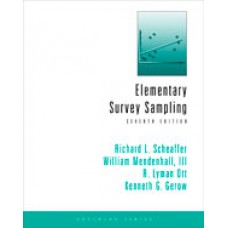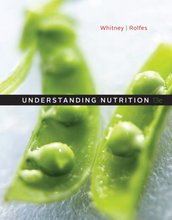This is completed downloadable of Solution Manual for Elementary Survey Sampling, 7th Edition

Product Details:
- ISBN-10 : 0840053614
- ISBN-13 : 978-0840053619
- Author:
ELEMENTARY SURVEY SAMPLING is an engaging and practical introduction to survey sampling. The book begins with real-world scenarios and uses easy-to-understand formulas, methodologies, and concepts to show how sample surveys are used in a wide variety of situations.
Table of Content:
- Chapter 1: Introduction
- Chapter 2: Elements of the Sampling Problem
- 2.1 Introduction
- 2.2 Technical Terms
- 2.3 How to Select the Sample: The Design of the Sample Survey
- 2.4 Sources of Errors in Surveys
- 2.5 Designing a Questionnaire
- 2.6 Planning a Survey
- 2.7 Summary
- Critical Thinking with Real Data
- Chapter 3: Some Basic Concepts of Statistics
- 3.0 Tools
- 3.1 Introduction
- 3.2 Summarizing Information in Populations and Samples: The Infinite Population Case
- 3.3 Summarizing Information in Populations and Samples: The Finite Population Case
- 3.4 Sampling Distributions
- 3.5 Covariance and Correlation
- 3.6 Estimation
- 3.7 Summary
- Chapter 4: Simple Random Sampling
- 4.0 Tools
- 4.1 Introduction
- 4.2 How to Draw a Simple Random Sample
- 4.3 Estimation of a Population Mean and Total
- 4.4 Selecting the Sample Size for Estimating Population Means and Totals
- 4.5 Estimation of a Population Proportion
- 4.6 Comparing Estimates
- 4.7 Summary
- Sampling from Real Populations
- A Sampling Activity—Random Rectangles
- Chapter 5: Stratified Random Sampling
- 5.0 Tools
- 5.1 Introduction
- 5.2 How to Draw a Stratified Random Sample
- 5.3 Estimation of a Population Mean and Total
- 5.4 Selecting the Sample Size for Estimating Population Means and Totals
- 5.5 Allocation of the Sample
- 5.6 Estimation of a Population Proportion
- 5.7 Selecting the Sample Size and Allocating the Sample to Estimate Proportions
- 5.8 Additional Comments on Stratified Sampling
- 5.9 An Optimal Rule for Choosing Strata
- 5.10 Stratification after Selection of the Sample
- 5.11 Double Sampling for Stratification
- 5.12 Summary
- Sampling from Real Populations
- Chapter 6: Ratio, Regression, and Difference Estimation
- 6.0 Tools
- 6.1 Introduction
- 6.2 Surveys that Require the Use of Ratio Estimators
- 6.3 Ratio Estimation Using Simple Random Sampling
- 6.4 Selecting the Sample Size
- 6.5 Ratio Estimation in Stratified Random Sampling
- 6.6 Regression Estimation
- 6.7 Difference Estimation
- 6.8 Relative Efficiency of Estimators
- 6.9 Summary
- Sampling from Real Populations
- Chapter 7: Systematic Sampling
- 7.0 Tools
- 7.1 Introduction
- 7.2 How to Draw a Systematic Sample
- 7.3 Estimation of a Population Mean and Total
- 7.4 Estimation of a Population Proportion
- 7.5 Selecting the Sample Size
- 7.6 Repeated Systematic Sampling
- 7.7 Further Discussion of Variance Estimators
- 7.8 Summary
- Sampling from Real Populations
- Chapter 8: Cluster Sampling
- 8.0 Tools
- 8.1 Introduction
- 8.2 How to Draw a Cluster Sample
- 8.3 Estimation of a Population Mean and Total
- 8.4 Equal Cluster Sizes: Comparison to Simple Random Sampling
- 8.5 Selecting the Sample Size for Estimating Population Means and Totals
- 8.6 Estimation of a Population Proportion
- 8.7 Selecting the Sample Size for Estimating Proportions
- 8.8 Cluster Sampling Combined with Stratification
- 8.9 Cluster Sampling with Probabilities Proportional to Size
- 8.10 Summary
- Sampling from Real Populations
- Chapter 9: Two-Stage Cluster Sampling
- 9.0 Tools
- 9.1 Introduction
- 9.2 How to Draw a Two-Stage Cluster Sample
- 9.3 Unbiased Estimation of a Population Mean and Total
- 9.4 Ratio Estimation of a Population Mean
- 9.5 Estimation of a Population Proportion
- 9.6 Sampling Equal-Sized Clusters
- 9.7 Two-Stage Cluster Sampling with Probabilities Proportional to Size
- 9.8 Summary
- Sampling with Real Populations
- Chapter 10: Estimating the Population Size
- 10.0 Tools
- 10.1 Introduction
- 10.2 Estimation of a Population Size Using Direct Sampling
- 10.3 Estimation of a Population Size Using Inverse Sampling
- 10.4 Choosing Sample Sizes for Direct and Inverse Sampling
- 10.5 Estimating Population Density and Size from Quadrat Samples
- 10.6 Estimating Population Density and Size from Stocked Quadrats
- 10.7 Adaptive Sampling
- 10.8 Summary
- Sampling from Real Populations
- Chapter 11: Supplemental Topics
- 11.0 Tools
- 11.1 Introduction
- 11.2 Interpenetrating Subsamples
- 11.3 Estimation of Means and Totals over Subpopulations
- 11.4 Random-Response Model
- 11.5 Use of Weights in Sample Surveys
- 11.6 Adjusting for Nonresponse
- 11.7 Imputation
- 11.8 Selecting the Number of Callbacks
- 11.9 The Bootstrap
- 11.10 Summary
- Sampling from Real Populations
- Chapter 12: Summary
- 12.1 Summary of the Designs and Methods
- 12.2 Comparisons among the Designs and Methods
- Appendix A: Bibliography, Tables, and Derivations
- Bibliography
- Tables
- Derivation of Some Main Results
- Appendix B: Macros for SAS
- 1 Introduction
- 2 Examples
- 3 Cluster Designs
- 4 Summary Statistics
- 5 Using Several Macros in One Program
- Appendix C: Data Sets
- Classsur: A Survey of Introductory Statistics Students
- Cars93: A Survey of Popular Cars for 1993
- Recycle: A Survey on Recycling Practices
- Schools: A Summary of Students, Teachers, and Expenditures for the 2000–2001 School Year, by State
- Temps: Monthly Normal Temperatures (T) and Precipitation (P) for U.S. Weather Stations*
- River: Flow Rates for Crystal River, Florida
- Selected Answers
- Index





